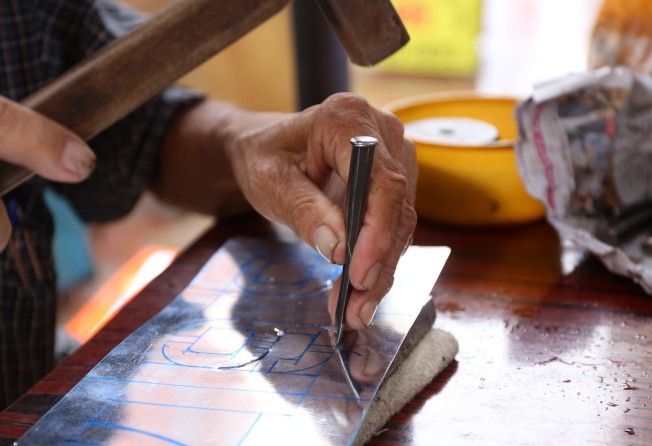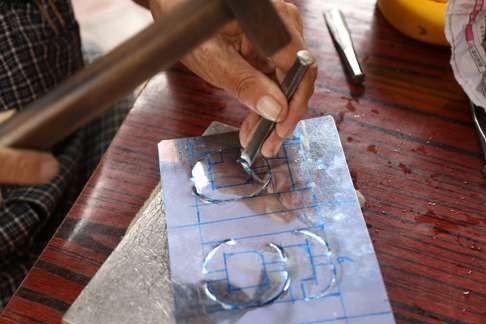Meet one of Hong Kong’s last working stencil makers
The digital age and the advent of laser cutters have had a huge impact on the city’s dwindling number of stencil makers. We talk to Wu Ding-keung, 80, about an industry that is coming under the hammer

Wu Ding-keung may be slow on his feet, but he has quick and adept fingers. With just a hammer and some chisels, the 80-year-old carves out a number on a thin iron sheet.
Five days a week, no matter the weather, the stencil maker sits at his stall on Argyle Street in Mong Kok, hammering away.
When we approach Wu, one of very few stencil makers left in Hong Kong, he is hanging up his calligraphy work on a piece of cardboard next to his stall and the rain is getting heavier and heavier. “What about another day?” he suggests. But he quickly changes his mind. “Let’s do it today. I may not be here if you come back another day.”
His stall has a simple set-up – just a parasol, table and stool. Wu takes his tools, all carefully wrapped in newspaper, from a nylon bag. As he pulls the string off one package, the iron sheet inside unfurls to reveal the template of a set of numbers.
Switching between different chisels, Wu traces along the lines on the template he’s drawn. Each set of numbers costs HK$800. The process may seem very straightforward, but the challenge lies in the details. For example, the amount of negative space between each stroke needs to be very precise. Too much, and the number will look incomplete; too little, and the corners of the iron sheet may break off.
The number seven, for example, needs to be separated into two strokes. Otherwise, when the stencil is painted over with a brush, the bristles may lift up the sharp corner. These tricks can only be learnt through years of experience.

In fact, his career as a stencil maker was spurred by his love for Chinese calligraphy. When he set up his workshop on Argyle Street 30 years ago, there were about a dozen, if not more, similar workshops in the area. Stencils were widely used to make advertising plates or wall signs. But orders have dwindled as commercial printing and laser cutting take over.
Wu, who can write in different font styles, writes menus for restaurants and Fai Chun (traditional decorations) during Lunar New Year. In the digital age, neat and meticulous handwriting like his is becoming more and more rare. But Wu says that’s not necessarily the case. “A lot of people still write very well. Beauty is in the eye of the beholder.”